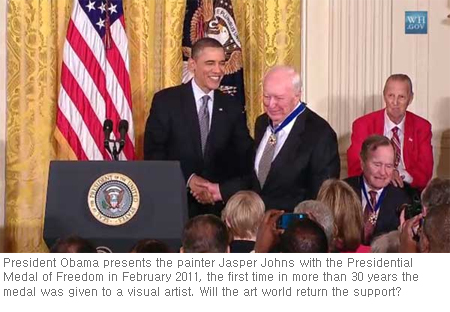미술계와 대통령 선거
By Christian Viveros-Fauné
Obama wins the art world’s support

President Obama presents the painter Jasper Johns with the Presidential Medal of Freedom in February 2011, the first time in more than 30 years the medal was given to a visual artist. Will the art world return the support?
Despite the introduction of policies that have alienated sections of the arts lobby, it looks as though key figures in the US art world will once again step up to back Barack Obama as their candidate in the presidential race.
In February 2008, the New York art dealer Paula Cooper hosted a function at her gallery. The fundraising event boasted a committee that included the artists Robert Wilson, Brice Marden, Mark di Suvero and Robert Gober. Six months before the next presidential election, the gallerist is again throwing her considerable weight behind the Democratic candidate.
“I think everyone is terrified,” Cooper says, a factor she believes will make the “Artists and Writers for Obama” event on 28 June a bigger success than the 2008 event. “This time, the arts community is very widely represented.” Tickets are $1,000 or $2,500, and guests can donate up to $35,800, the maximum legally allowed for individual campaign contributions. Among those expected to attend are the artists Richard Serra, Glenn Ligon, Cecily Brown, Cindy Sherman and Laurie Anderson, the architect Frank Gehry, the collector Agnes Gund, Kynaston McShine, the chief curator-at-large at the Museum of Modern Art, New York, and the art dealers Barbara Bertozzi Castelli, Carolyn Alexander, Lawrence Luhring and Roland Augustine. (For Obama and the Republican candidate Mitt Romney’s campaign contributors, click here.)
Last month, a $5,000-ticket Obama fundraiser at New York’s Rubin Museum, hosted by the singer Ricky Martin and the museum’s founders, Donald and Shelley Rubin, raised $1m. And in March, Michelle Obama held a fundraiser at the Walker Art Center, Minneapolis, that netted $90,000.
Obama’s support in the art world has foundered since his election. In 2010, he proposed consolidating grants programmes for education, leaving the arts to compete for funding with science and literacy programmes, and the National Endowment for the Arts’ funding was cut by $6m in 2011. Additionally, the administration made questionable appointments to key posts, such as the Chicago lawyer Kareem Dale, who was appointed “arts tsar” despite having limited arts experience. Criticism from arts advocates was swift.
Yet there have been policy reversals and triumphs. Obama’s proposed 2013 arts budget has increased by 5%, and his administration has streamlined the process for artists’ visas, increased the state department’s cultural diplomacy budget by 40% to $11.8m and allocated $1m for US artists to create public works in 15 countries through the Smart Power programme. Robert Lynch, the president of Americans for the Arts, a group based in Washington, DC, says: “The White House is sending a clear message that it understands the importance of the creative sector to our communities and the economy.” The artist Chuck Close, who sits on the president’s Committee on Arts and the Humanities, sees Obama’s support of arts education “during a time of fiscal austerity” as fundamental. “Obama must be re-elected,” he says.
